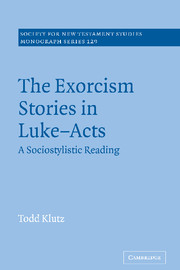Book contents
- Frontmatter
- Contents
- Acknowledgements
- List of abbreviations
- Introduction
- 1 Sociostylistics and the exorcism in Luke 4.33–37
- 2 Purity and the exorcism in Luke 8.26–39
- 3 Discipleship and the exorcism in Luke 9.37–43a
- 4 Paul, Jewish identity, and the exorcism in Acts 16.16–18
- Conclusion
- Bibliography
- Index of sources discussed
- Index of names and subjects
1 - Sociostylistics and the exorcism in Luke 4.33–37
Published online by Cambridge University Press: 22 September 2009
- Frontmatter
- Contents
- Acknowledgements
- List of abbreviations
- Introduction
- 1 Sociostylistics and the exorcism in Luke 4.33–37
- 2 Purity and the exorcism in Luke 8.26–39
- 3 Discipleship and the exorcism in Luke 9.37–43a
- 4 Paul, Jewish identity, and the exorcism in Acts 16.16–18
- Conclusion
- Bibliography
- Index of sources discussed
- Index of names and subjects
Summary
Recent efforts by linguists and literary theorists to build an interface between their respective disciplines have produced analytical methods that have much to offer anyone interested in the relations between texts and their extratextual contexts of production. As these methods not only contribute to the type of discourse analysis used in the present study but also differ in various ways from most other forms of critical practice in biblical studies, their distinctive vocabulary and position in contemporary theoretical discussion ought to be clarified at the outset. However, in order to keep this part of the work close to my primary interest (i.e., to apply the methods to the exorcism stories of Luke–Acts), the illustration of critical concepts in the present chapter focuses as much as possible on the exorcism in Luke 4.33–37; thus, while a few essential matters of terminology and theory are treated on their own in the immediately ensuing sections, the method and its application are tightly integrated throughout the rest of the chapter.
Sociostylistic theory
Like most varieties of stylistics, the critical practice of sociostylistics consists primarily of the analysis of linguistic style. However, as the phrase ‘linguistic style’ can convey several different meanings, it too needs to be defined if the method and object of the present study are to be understood clearly. In this connection, the definition offered by the Finnish linguist N. Enkvist is particularly helpful. In Enkvist's view, linguistic style is situationally conditioned choice.
- Type
- Chapter
- Information
- The Exorcism Stories in Luke-ActsA Sociostylistic Reading, pp. 15 - 81Publisher: Cambridge University PressPrint publication year: 2004



